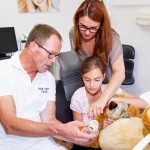
Sadly caries remains a significant public health problem across the world, particularly in children. The aim of this study was to assess the cost-effectiveness of caries treatment and prevention strategies in the Netherlands.
The study was conducted alongside a randomised controlled trial (RCT) evaluating the effects of two caries prevention strategies compared with regular dental care among 6-year-olds. 230 children were randomly assigned to one of three groups: –
- Control group. This group received standard dental care: dental check-ups twice a year, including professional fluoride gel applications (1.23% F–) and preventive pit and fissure sealants after eruption of the permanent molars, on a routine basis. The threshold for placing restorations was set at the d3/D3 level
- Increased professional fluoride application (IPFA) group: – received care as per control group with 2 additional professional fluoride gel applications (1.23% F–).
- Non-operative caries treatment and prevention (NOCTP) had individualized risk-based recall intervals based on Nexø study protocol (Ekstrand & Christiansen 2005). At each visit, areas where plaque removal and fluoride toothpaste needed to be more effectively applied were identified and instruction was given how to clean these areas. If progression of the caries process was controlled, fluoride varnish was applied locally. If, at a following visit, there was still no stabilisation or caries inhibition, the surface was sealed or, if the caries process had reached the D3 level, it was restored.
Clinical outcomes were collected over a 3-year period and caries increment scores at (D3MFS level were used to measure effectiveness.
In calculating costs, in addition to medical costs, out-of-pocket expenses (e.g. toothbrushes, toothpaste), travel costs to the clinic, travel time and time required to accompany the child were included. Medical costs were determined for each patient based on clinical timings and personnel involved using actual expenditure instead of fixed costs for each strategy.
- 179 out of 230 children completed the trial (77.8%)
- 63 in the control group programme, 62 in the IPFA and 54 in the NOCTP programme. This is a 32% drop out in the NOCTP group 20% in the IPFA group and 15% in the control group.
Resources use and total costs in Euros over 3 years are shown in the table below:-
|
Control Group |
IPFA Group |
NOCTP Group |
|
| Dentist contact time (mins) |
30 |
39 |
34 |
| Dental auxiliary contact time (mins) |
20 |
39 |
3 |
| Number of clinic visits |
7.1 |
11.2 |
7.7 |
| Total accompanying time |
99 |
156 |
91 |
| Total costs(0% discount rate) |
€310 (95% CI €330-€290) |
€494 (95%CI €468-€519) |
€329 (95% CI €308-€351) |
Average additional cost of preventing one DMFS are shown in the table below:-
| Health care costs | Societal costs | |
| IPFA v Control |
€269 |
€1,369 |
| NOCTP v Control |
€30 |
€100 |
The authors concluded
The NOCTP regimen was more effective and more costly than regular dental care. Based on the limited available amount of evidence regarding the willingness to pay for dental care, the benefits seem to outweigh the additional costs, implying that this is a cost-effective strategy. Increasing the number of professional fluoride applications resulted in a slight reduction of caries increment, but at higher costs than the NOCTP strategy. The results of this study confirm the findings in previous research. Therefore, implementing NOCTP on a larger scale should be considered.
Comment
Both the test groups were seen to be more costly than the control approach but both these approaches were more effective in preventing disease. While it is perhaps surprising that the IPFA group with just two more additional visits were considerably more expensive than the NOCTP group that groups costs dropped year on year which the authors considered could indicate that it would be more cost saving in the long-term. The authors also highlighted the high overall drop out rate in the trial, which was particularly high in the NOCTP group.
Links
Vermaire JH, van Loveren C, Brouwer WB, Krol M. Value for Money: Economic Evaluation of Two Different Caries Prevention Programmes Compared with Standard Care in a Randomized Controlled Trial. Caries Res. 2014 Feb 12;48(3):244-253. [Epub ahead of print] PubMed PMID: 24526078.
Ekstrand KR, Christiansen ME. Outcomes of a non-operative caries treatment programme for children and adolescents. Caries Res. 2005 Nov-Dec;39(6):455-67. PubMed PMID: 16251789.
Vermaire JH, van Exel NJ, van Loveren C, Brouwer WB. Putting your money where your mouth is: parents’ valuation of good oral health of their children. Soc Sci Med. 2012 Dec;75(12):2200-6. doi: 10.1016/j.socscimed.2012.08.018. Epub 2012 Sep 10. PubMed PMID: 22995665.

A risk based non-operative caries Tx approach may be more cost effective than traditional approaches http://t.co/nN4TAt4WiT via @sharethis
My brother recommended I may like this website. He used to be totally right. This post truly made my day. You can not consider simply how so much time I had spent for this info! Thanks! kcacbkkbdkef